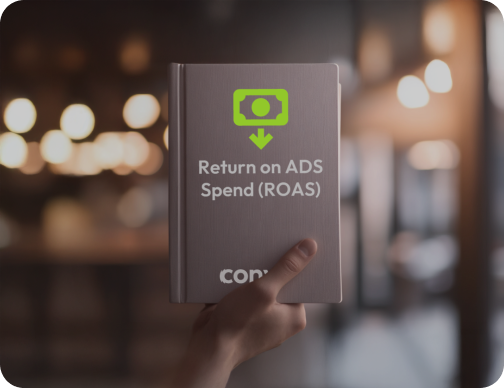Return on Ad Spend (ROAS)
The ROAS calculator helps assess return on ad spend – a key metric that reflects the effectiveness of paid advertising.



What is ROAS?
Return on Ad Spend (ROAS) is the amount of revenue a company generates for every dollar spent on advertising. In other words, ROAS measures the efficiency of advertising expenses.
When a business tests a new advertising channel for a campaign, it can compare ROAS across different campaign stages and advertising sources to evaluate their effectiveness and determine which channels are worth using in the future.
Three main types of ROAS calculation: Basic ROAS calculation expressed as a percentage, target ROAS calculation, and margin-based ROAS.
How to calculate ROAS as a percentage?
- Enter Ad Spend – Specify the budget allocated to an advertising channel.
- Enter Revenue from Ads – Provide the revenue generated from a specific advertising source to obtain the ROAS result.
- Interpret the results. If ROAS = 500%, it means the advertising source generates €5 in revenue for every €1 spent on advertising.
Basic ROAS calculation (expressed as a percentage)
Using the ROAS calculator, you can accurately assess advertising performance and make informed decisions about your advertising strategy.

What is considered a good ROAS?
This metric depends on various factors – the nature of the products being sold, the specifics of the target audience, market competition, and the chosen advertising platform.
The average ROAS in e-commerce is 287%, meaning that each euro invested generates an average of €2,87 in revenue. However, this figure should not be interpreted universally — in many cases, a target ROAS of at least 300% or 400% is considered acceptable, depending on the specific industry and strategic business objectives.
Why is it important to calculate target ROAS?
By using the target ROAS calculator, you can make strategic decisions that help allocate your ad budget more effectively and optimize campaign profitability.
ROAS helps establish a smart bidding strategy aimed at maximizing conversion value.
It allows you to assess the effectiveness of advertising campaigns and make data-driven decisions.
Optimizing ROAS not only increases the number of conversions but also their value, leading to higher profits.
Target ROAS can be set for individual campaigns, ad groups, keywords, or products to maximize advertising efficiency.
How to calculate Target ROAS?
- Set Your Desired Advertising Revenue – This is the amount you expect to generate from your advertising campaign. For example, if your goal is to earn €50,000 in revenue.
- Determine Your Planned Ad Budget – This is the amount you plan to spend on advertising. For example, if your ad budget is €10,000.
- Input the Data into the Calculator and Interpret the Results – If the target ROAS = 5, this means the campaign must generate €5 in revenue for every €1 spent on ads.
Target ROAS calculator
This calculator helps clearly assess expected returns and allows you to compare actual results with predefined goals.

Profit ROAS calculation
Profit ROAS, calculated based on profit margin, provides a more accurate measure of advertising effectiveness by assessing not only revenue generated but also overall profitability.
First, calculate your profit margin.
The higher your profit margin, the lower the required ROAS.
Lower profit margin? Then you need a higher ROAS.
In order to achieve 100% profit, you must establish how many times your current profit margin needs to be multiplied.
How to Calculate Profit ROAS?
Let’s say your profit margin is 25%. This means that after covering all business expenses—rent, salaries, production, advertising agency fees, and other costs—you still retain 25% of your revenue as profit.
In this case, to ensure profitability, your ROAS goal should be higher than 400%.
Remember: The lower your profit margin, the higher your required ROAS to make your ad campaigns profitable!
How to Calculate Profit ROAS?
- Identify your current profit margin.
This is the percentage that shows how much profit remains after all expenses. Example: your profit margin is 25%. - Use the following formula to determine how many times your profit margin must be multiplied to reach 100% profit:
y = 100% / current profit margin (%)
- Interpret the result.
This means your profit margin needs to be multiplied by 4 (4X) to achieve 100% profit. - Convert the resulting factor into a ROAS percentage.
Do this by multiplying the factor by 100 and adding the percentage sign:4 = 400 % ROAS
1,5 = 150 % ROAS
Profit ROAS Calculator
This calculator helps clearly assess expected returns and allows you to compare actual results with predefined goals.
F.A.Q.
- Other metrics like CTR (click-through rate), impressions, or cost per conversion are important, but they don’t reveal how much revenue your ads actually generate.
- You might have a campaign that appears weak in terms of traffic but delivers the highest profit.
- On the other hand, a campaign with many clicks could be financially unsustainable if conversion costs exceed the revenue per sale.
ROAS data can have a massive impact on your business. While calculating ROAS and setting a strong goal is easy, achieving it is not. That’s why many businesses hire PPC (Pay-Per-Click) advertising agencies, which:
- Analyze and track campaign data
- Optimize ads based on ROAS
- Strategically allocate the ad budget
- Brand Awareness
If you’re a new brand, your ROAS is likely to be lower than that of well-established competitors. Over time, as brand recognition grows, ad performance can improve. - Ad Type and Channel
- Display adstend to have lower ROAS since users are less likely to click on them. However, they contribute to brand awareness.
- Search and social media ads typically yield better results because they target specific audiences and avoid irrelevant impressions.
- Underperforming Campaigns:
If you’ve entered a new market but your ROAS drops below 300%, consider:
Adjusting audience targeting
Adding new ad creatives
Optimizing the campaign to maximize your ad budget - Customer Reviews:
Positive reviews build trust and encourage purchases, while negative feedback can decrease conversion rates and lower ROAS. - Product or Service Descriptions & Visuals:
Clear, detailed descriptions
High-quality images and videos
These elements improve buying decisions and increase conversions. - Product Pricing
Overpriced products or those misaligned with market expectations can drive customers away, lowering ROAS. Competitive pricing can help improve performance.